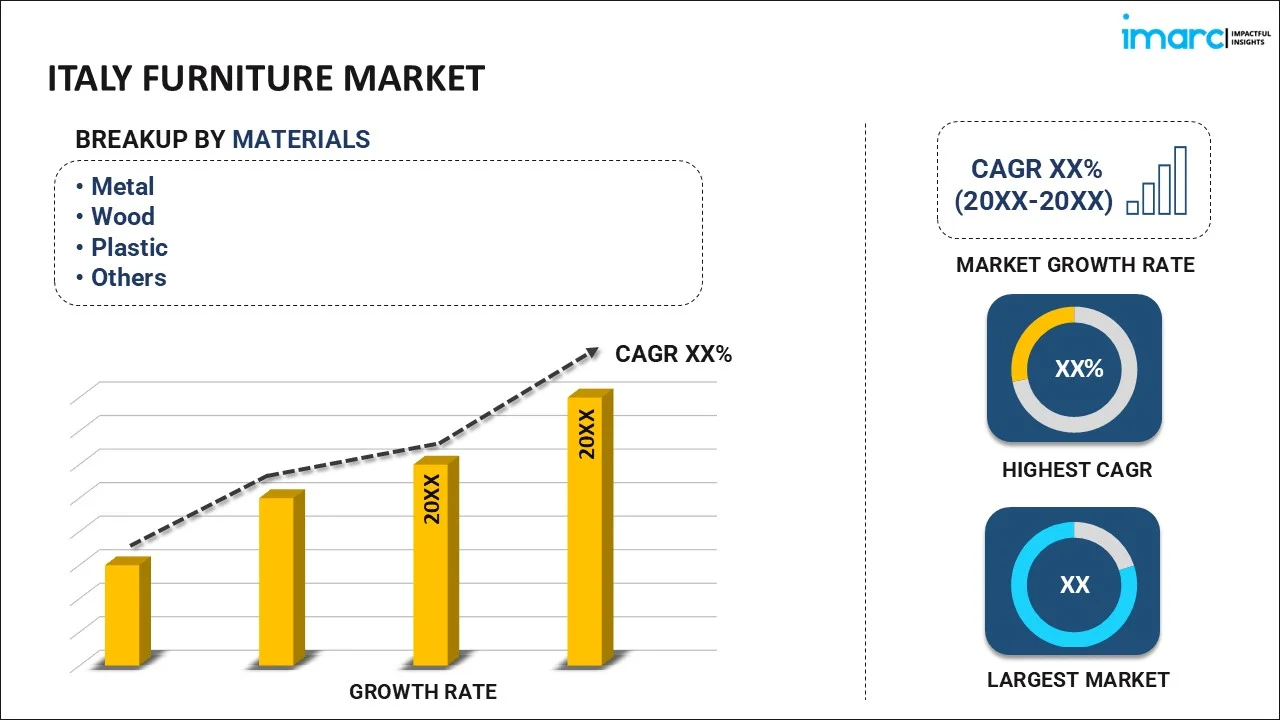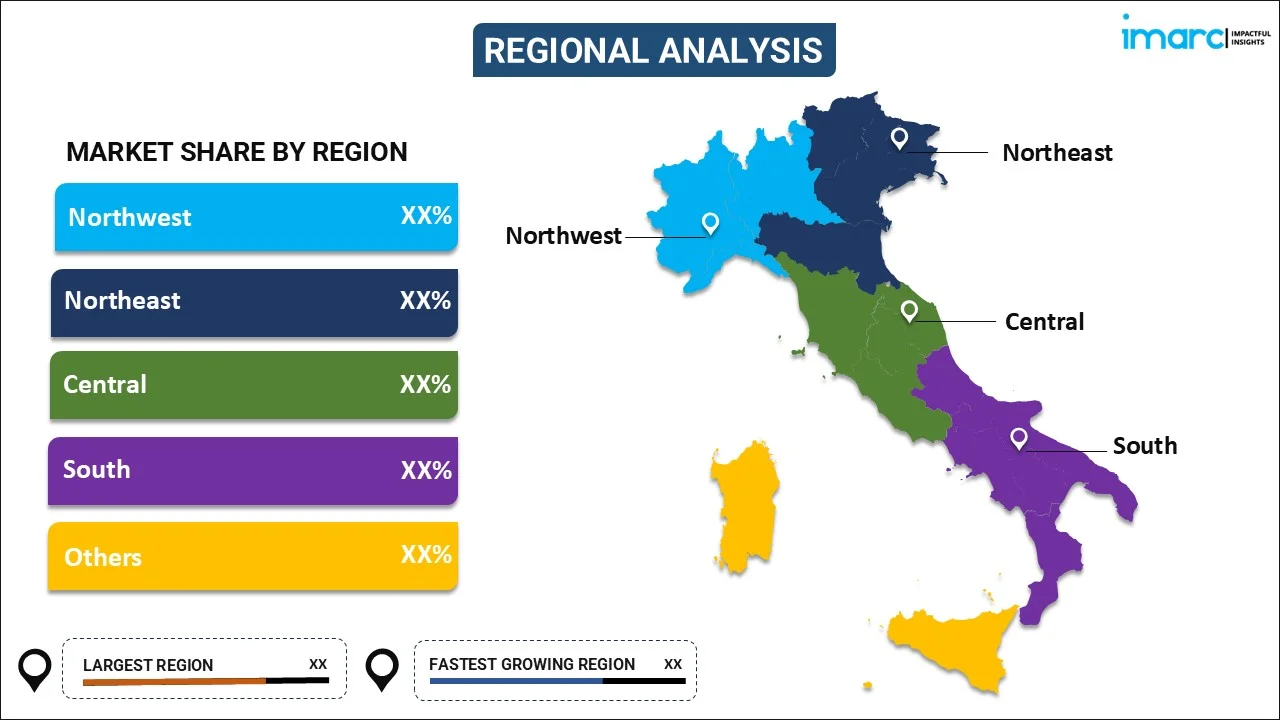
Italy Furniture Market Size, Share, Trends and Forecast by Material, Distribution Channel, End Use, and Region, 2025-2033
Italy Furniture Market Overview:
The Italy furniture market size reached USD 26.70 Billion in 2024. Looking forward, IMARC Group expects the market to reach USD 42.08 Billion by 2033, exhibiting a growth rate (CAGR) of 4.80% during 2025-2033. Italy's furniture market is driven by strong export demand, a robust domestic economy supporting consumer spending, government-backed trade initiatives, and innovation in sustainable and luxury furniture design, all of which contribute to the industry's resilience and competitive positioning in the global market
|
Report Attribute
|
Key Statistics
|
|---|---|
|
Base Year
|
2024
|
|
Forecast Years
|
2025-2033
|
|
Historical Years
|
2019-2024
|
| Market Size in 2024 | USD 26.70 Billion |
| Market Forecast in 2033 | USD 42.08 Billion |
| Market Growth Rate (2025-2033) | 4.80% |
Italy Furniture Market Trends:
Export Performance
Italy's furniture sector is export-oriented, and foreign demand is the driving force behind its expansion. Italian exports rose by 1.9% in the fourth quarter of 2023 compared to November 2023. The growth was especially high in areas like the Centre (+8.1%), the South and Islands (+3.5%), and the North-West (+2.1%), while the North-East had a marginal drop of 0.7%. The performance in exports testifies to the popularity of Italian furniture worldwide due to its quality, design, and craftsmanship. The capacity of the industry to learn and fit into global market patterns and preferences has been key to sustaining and widening its global market share. Furthermore, the diversification of destinations for export has assisted in risk reduction owing to economic upturns and downturns in certain markets. Government programs enhancing foreign trade, including trade policies and promotional fairs, have further strengthened the export potential of the industry. These programs have ensured greater access to markets and increased the competitive strength of Italian furniture producers at the international level.
Domestic Economic Conditions
The local economic climate heavily affects the Italian furniture sector. Italy's Gross Domestic Product (GDP) rose by a slight 0.2% in December 2024 relative to the previous quarter. Economic stability gives way to consumer confidence and purchasing power, which are crucial for the furniture sector’s growth. Furthermore, the performance of the construction industry has a direct impact on furniture demand. Additionally, inflation rates also have an impact on consumer purchasing power. In January 2025, the Consumer Price Index (CPI) rose by 0.6% compared to December 2024 and by 1.5% year-on-year. Although moderate inflation can be a sign of an expanding economy, it also impacts the price of raw materials and production for furniture makers, which can result in escalating prices for consumers. Moreover, the dynamics of the Italian furniture sector are largely determined by its export performance and the domestic economy. Maintaining growth hinges on a balanced strategy that capitalizes on international market opportunities while developing a strong domestic economy to underpin consumer demand.
Italy Furniture Market Segmentation:
IMARC Group provides an analysis of the key trends in each segment of the market, along with forecasts at the region/country level for 2025-2033. Our report has categorized the market based on material, distribution channel, and end use.
Material Insights:

- Metal
- Wood
- Plastic
- Glass
- Others
The report has provided a detailed breakup and analysis of the market based on the material. This includes metal, wood, plastic, glass, and others.
Distribution Channel Insights:
- Supermarkets and Hypermarkets
- Specialty Stores
- Online Stores
- Others
A detailed breakup and analysis of the market based on the distribution channel have also been provided in the report. This includes supermarkets and hypermarkets, specialty stores, online stores, and others.
End Use Insights:
- Residential
- Commercial
A detailed breakup and analysis of the market based on the end use have also been provided in the report. This includes residential and commercial.
Regional Insights:

- Northwest
- Northeast
- Central
- South
- Others
The report has also provided a comprehensive analysis of all the major regional markets, which include Northwest, Northeast, Central, South, and others.
Competitive Landscape:
The market research report has also provided a comprehensive analysis of the competitive landscape. Competitive analysis such as market structure, key player positioning, top winning strategies, competitive dashboard, and company evaluation quadrant has been covered in the report. Also, detailed profiles of all major companies have been provided.
Italy Furniture Market News:
- February 2025: Italy is focusing on India's growing market for luxury furniture and home décor, seeing its positive economic growth and rising purchasing power. Italian furniture exports to India increased by 19.1% in 2023 compared to 2022, reaching €112 million. This Indian focus is intended to expand Italy's furniture sector by accessing new demand and reinforcing global trade relations.
Italy Furniture Market Report Coverage:
| Report Features | Details |
|---|---|
| Base Year of the Analysis | 2024 |
| Historical Period | 2019-2024 |
| Forecast Period | 2025-2033 |
| Units | Billion USD |
| Scope of the Report |
Exploration of Historical Trends and Market Outlook, Industry Catalysts and Challenges, Segment-Wise Historical and Future Market Assessment:
|
| Materials Covered | Metal, Wood, Plastic, Glass, Others |
| Distribution Channels Covered | Supermarkets and Hypermarkets, Specialty Stores, Online Stores, Others |
| End Uses Covered | Residential, Commercial |
| Regions Covered | Northwest, Northeast, Central, South, Others |
| Customization Scope | 10% Free Customization |
| Post-Sale Analyst Support | 10-12 Weeks |
| Delivery Format | PDF and Excel through Email (We can also provide the editable version of the report in PPT/Word format on special request) |
Key Questions Answered in This Report:
- How has the Italy furniture market performed so far and how will it perform in the coming years?
- What is the breakup of the Italy furniture market on the basis of material?
- What is the breakup of the Italy furniture market on the basis of distribution channel?
- What is the breakup of the Italy furniture market on the basis of end use?
- What are the various stages in the value chain of the Italy furniture market?
- What are the key driving factors and challenges in the Italy furniture?
- What is the structure of the Italy furniture market and who are the key players?
- What is the degree of competition in the Italy furniture market?
Key Benefits for Stakeholders:
- IMARC’s industry report offers a comprehensive quantitative analysis of various market segments, historical and current market trends, market forecasts, and dynamics of the Italy furniture market from 2019-2033.
- The research report provides the latest information on the market drivers, challenges, and opportunities in the Italy furniture market.
- Porter's five forces analysis assist stakeholders in assessing the impact of new entrants, competitive rivalry, supplier power, buyer power, and the threat of substitution. It helps stakeholders to analyze the level of competition within the Italy furniture industry and its attractiveness.
- Competitive landscape allows stakeholders to understand their competitive environment and provides an insight into the current positions of key players in the market.
Need more help?
- Speak to our experienced analysts for insights on the current market scenarios.
- Include additional segments and countries to customize the report as per your requirement.
- Gain an unparalleled competitive advantage in your domain by understanding how to utilize the report and positively impacting your operations and revenue.
- For further assistance, please connect with our analysts.
 Request Customization
Request Customization
 Speak to an Analyst
Speak to an Analyst
 Request Brochure
Request Brochure
 Inquire Before Buying
Inquire Before Buying




.webp)




.webp)












